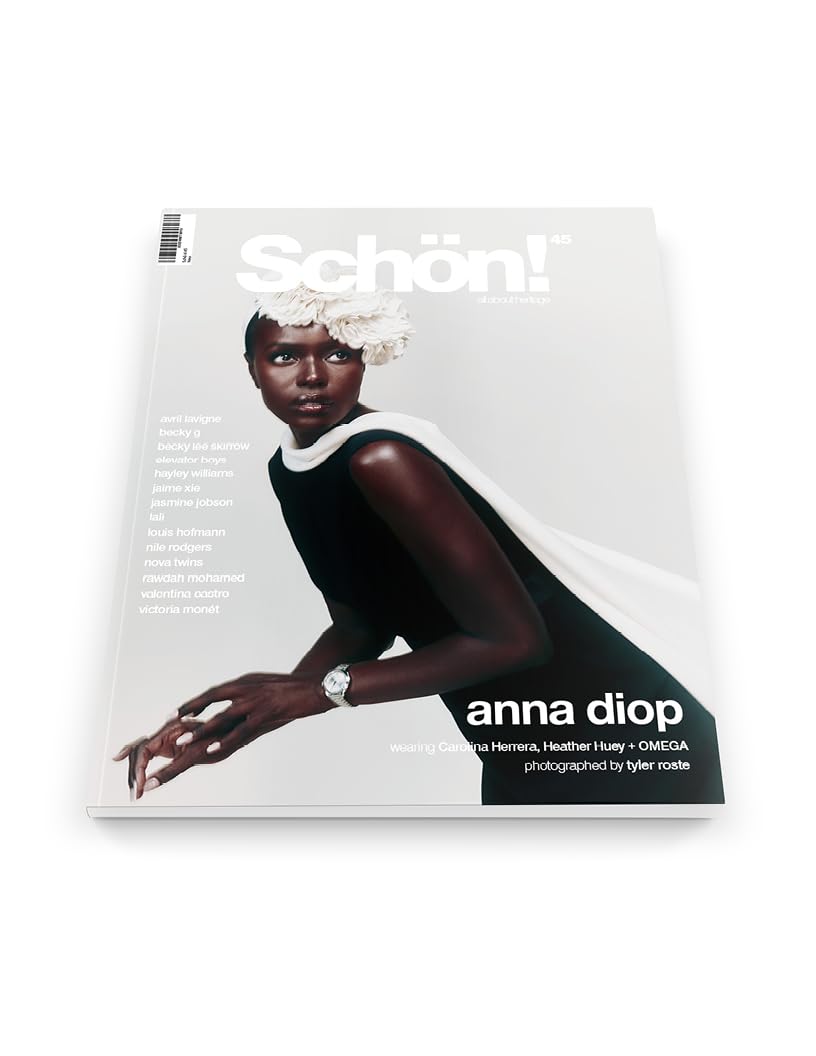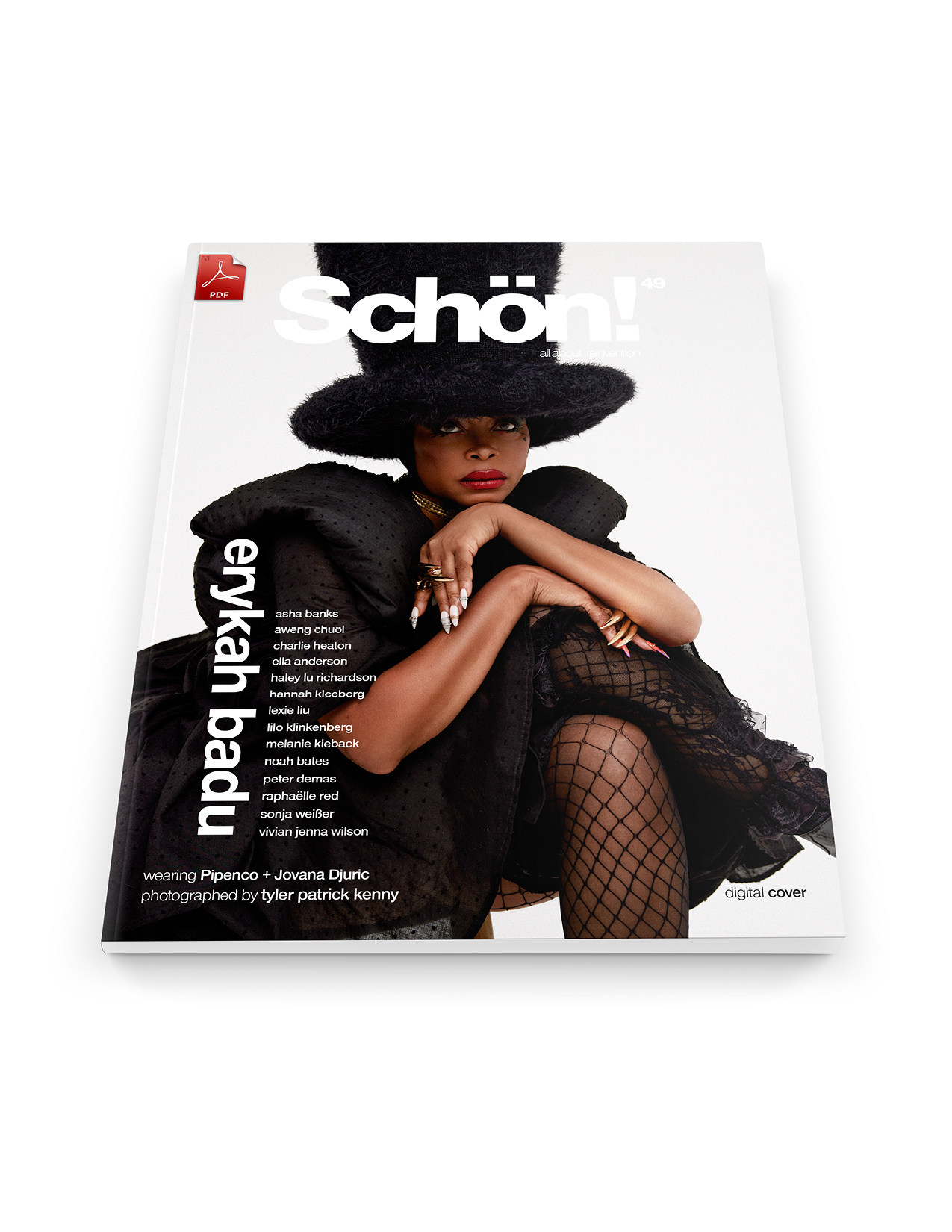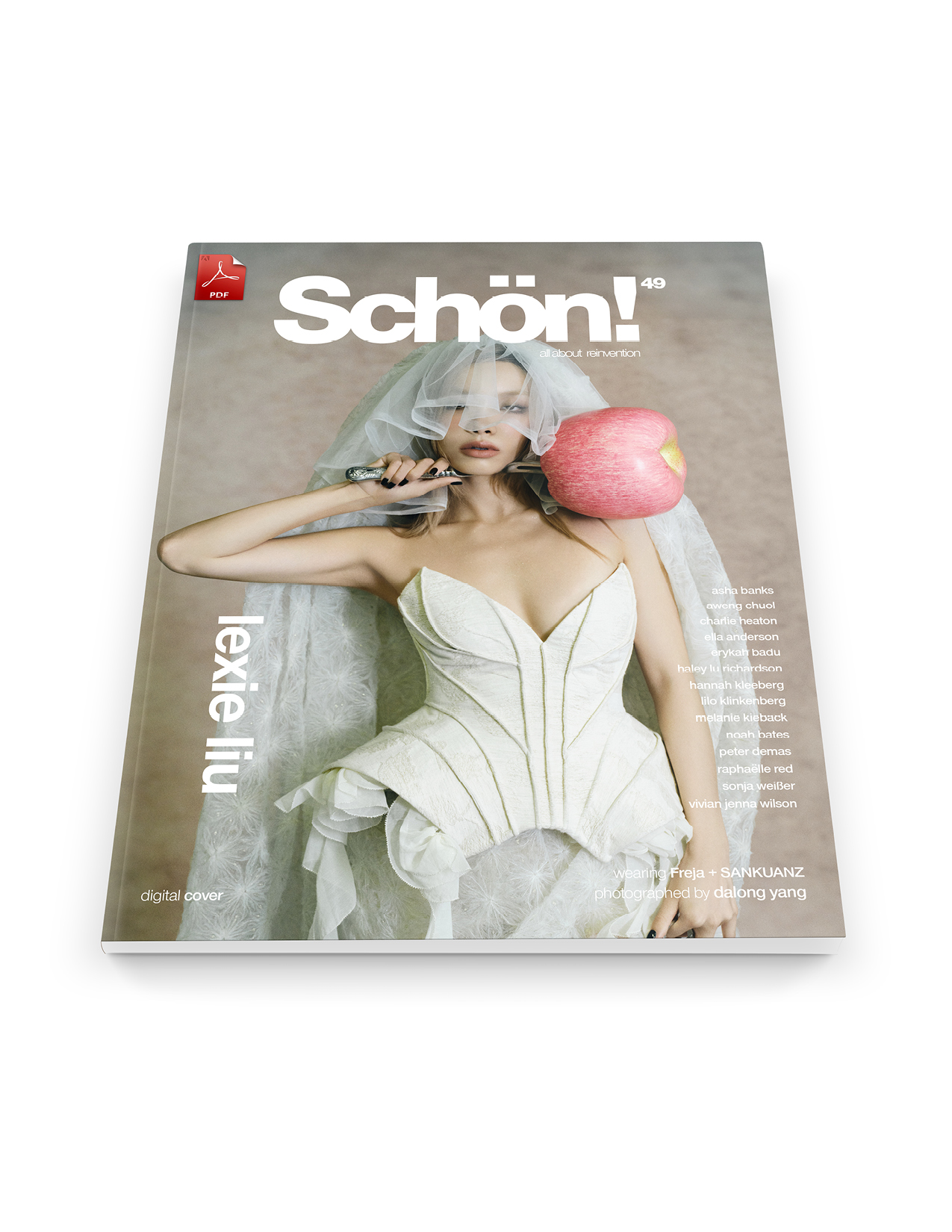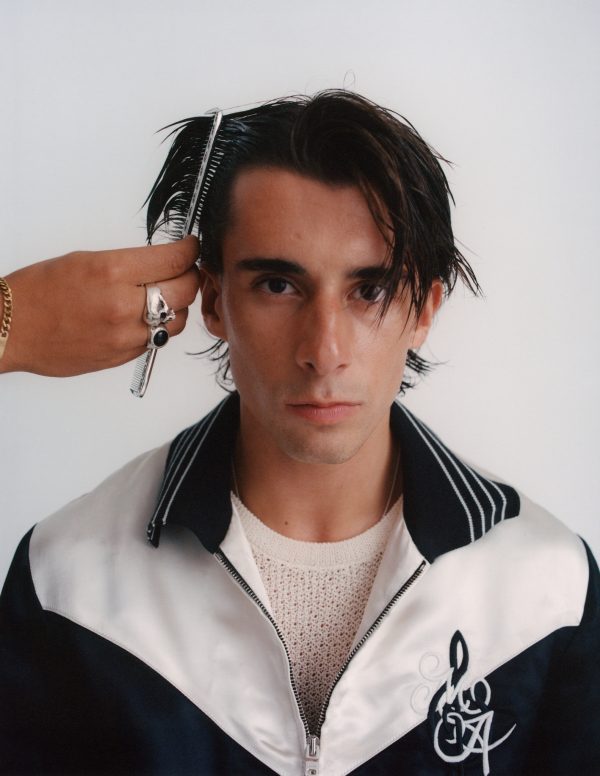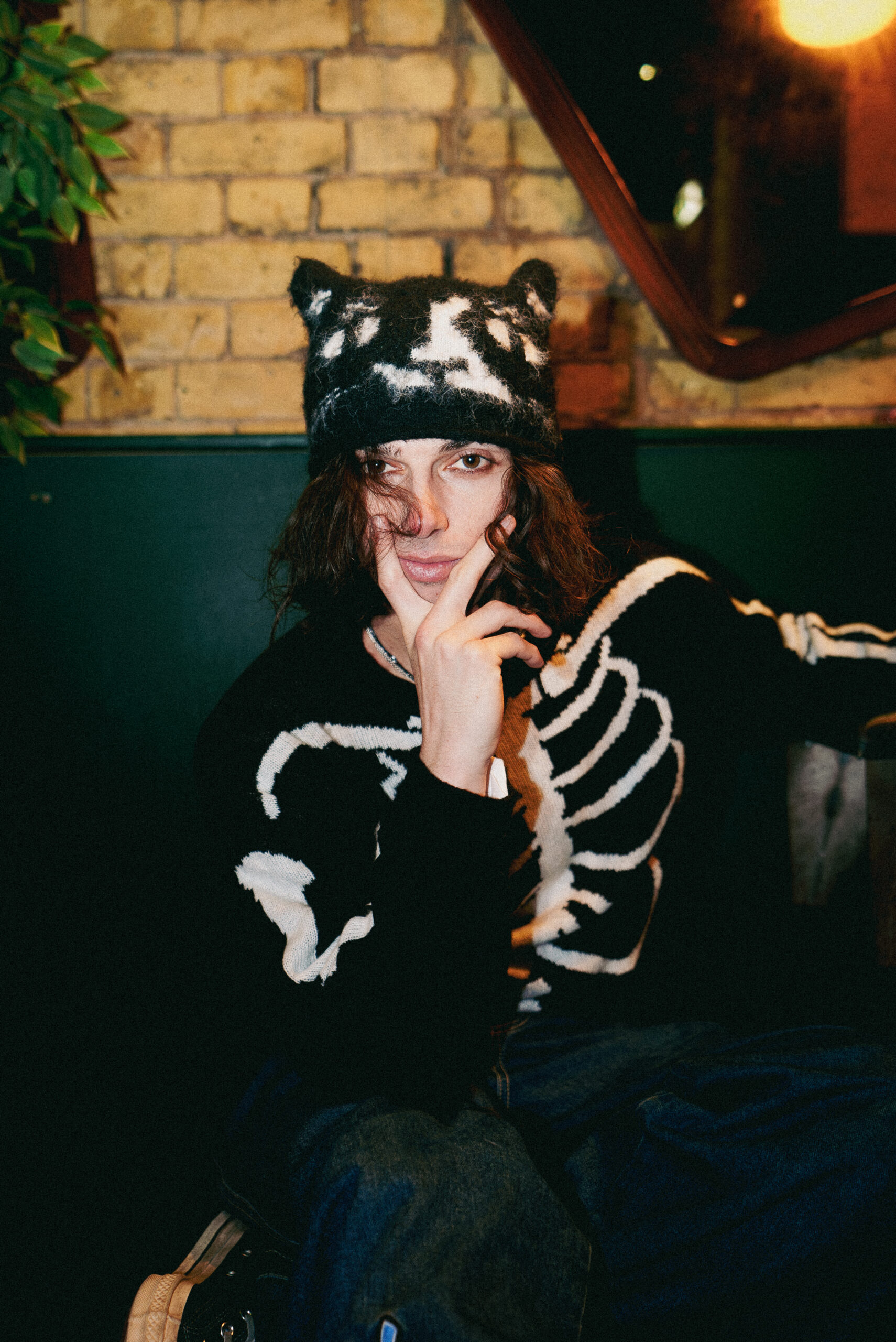Frida Gustavsson’s ease as the heroic Freydis in Netflix’s adventure series Vikings: Valhalla is the result of many factors — intense physical training, her invigorating relationship with nature and being a natural performer. As we speak her body language is animated, acting out every train of thought, and the Zoom call becomes far more evocative than a simple two-dimensional experience. Her physicality lends well to her role in the epic series, set long after the original Vikings series, where her character’s brutality is met with intense human emotion. Frida chats with Schön! about the multidimensional Freydis, solo hikes and learning to love her body.
What has been your favourite thing that’s happened so far in 2022?
I guess it’s been uneventful. I got Corona, I had to isolate and I got my booster shot yesterday — is that too depressing to say that’s the best thing that’s happened so far? I spent New Year’s Eve on the sofa, just me and my boyfriend. We watched all the Harry Potter movies, had some champagne and were coughing at each other. So not very romantic!
What attracted you to Vikings: Valhalla?
It’s such an incredible project! I was a huge fan of the original show. To hear that they were going to make a brand-new show with the same DNA, and that there was this fierce woman warrior called Freydis, how can you not want to do that?
Can you tell us a bit more about Freydis?
Freydis comes from Greenland, she arrives in Kattegat, which is a remnant of the old story, with her brother as an outsider. The Vikings have kind of separated into two; we have the Christian Vikings which are taking over and then the believers of the old ways, and Freydis is one of them. She embarks on this incredible journey to become this fierce warrior and leader of the pagans.
How did you find being a strong female character in such a male-dominated cast?
I enjoyed the boys a lot, but what I thought was really interesting is it’s actually Freydis’ seeking revenge that drives the story. All of the boys are battling and banging their chest, but I think it’s such an interesting storyline of a woman finding herself and her spirituality, despite being a survivor of something so traumatic. The women of the show carve their own little place.
You have a lot of scenes by yourself, how did you prepare for those in particular?
It’s so nice, because you don’t have to deal with anyone else! I’m just kidding. What really attracted me to Freydis is that she’s a very physical character to play; she doesn’t say a lot. So, it’s really interesting to just dive into the physicality of her. I enjoyed that. I think it’s a gift as an actor to be able to have moments where the audience can just breathe out and be there with you. I try to just prepare as much as I can, as I’m sure anyone would say, and just be there, be Freydis.

dress. Stand Studio
shoes. Our Legacy
socks. Weekday
earrings. All Blues
opposite
blazer. Shop Vintage Collection
top + shorts. Samsøe Samsøe
shoes. Our Legacy
socks. Weekday
earrings. All Blues
How did you find the physicality of it? Did you do a lot of training?
Oh my God, so much training! Most women all over the world, unfortunately, usually train to stay thin because it’s the ideal in society. For the first time, I had to train to bulk up to be able to do all these fights, to wear my armour because it’s so heavy; it’s actually the heaviest out of anyone’s armour. It was a huge physical transformation for me — I gained about six or seven kilos of muscle in a short amount of time. I was locked down in my country house throwing logs and tyres waiting to start filming.
Do you think you’ll return to your old fitness routine after filming?
Never. I’m so obsessed with it now. It’s really opened something inside me. I’ve always been really tall and very thin and had a pretty strange relationship with my body. I never felt that I fit in. Now, it’s like something has unleashed inside of me where I feel strong. I feel good, and I can carry heavy shit.
How did you find doing your own stunts?
Amazing! The stunt crew started us with the basics. I got a little knife in the beginning and I put all these dots on my apartment walls, like a fake opponent — if anybody walked by they would have thought I was crazy. Then I got a sword, a shield, a spear and learned how to throw some actual punches. It helps the production knowing that the main cast can perform our own stunts, but, of course, the stunt crew that we have are wildly more talented than we are. If there is something incredibly dangerous, like burning, they’re gonna step in and save us. It is a pretty violent show. Freydis never seems to have an easy day! Of course, you don’t want to see her walking around in the forest. I cracked a couple of teeth clenching so much from being so tense during those scenes.
What do you think will be your biggest takeaway from the show?
What is so unique about working on this show is that we created it under such extreme circumstances with the pandemic. We had to postpone the start of it, which meant we got a lot of prep time. We really got to learn a lot about each other and slowly became a little family.

blazer. Saint Laurent
turtleneck. Samsøe Samsøe
earrings. All Blues
opposite
dress. Valentino
jeans + shoes. Our Legacy
earrings. All Blues
Do you think forming a relationship with your co-stars helps your performance?
I think so, but if not, I guess we’re better actors. I think it helps really trusting the people you’re with; it helps us to push each other further. Now we can be as open and authentic with each other as possible and that creates a safe space for people.
The series was filmed in Ireland, and obviously, you travelled quite a lot while modelling. Where are your favourite places to visit?
I love travelling. It’s something I’ve missed so much with the COVID pandemic. I think it’s really important to help people gain a different, less familiar, perspective. But I’m a pretty strange person, I like to go on solo hikes. I take my miniature tent, my backpack, my survival kit, and just go off on my own for a couple of days. Just completely recharge. I don’t speak to anyone. I barely even read anything — just sit and stare at a mountain. It makes me sound like a lunatic. We shoot for six months of a year, and Ireland is such an incredibly beautiful place. Sometimes I have a couple of days off, so I drive out into the wild Atlantic Way of Ireland and hang out by myself with some sheep. But I’m Swedish, and I love the north of Sweden. It’s such an incredible place. It’s north of the Arctic Circle, and in the summer the sun never sets. You sit in your tent and there’s just a huge orange globe hovering over the edge of the mountains in the distance, and it’s very humbling.
What do you think is the biggest challenge transitioning from being a model to an actress?
I think it’s a huge misconception that modelling is something that is incredibly easy and that models are stupid. In the ten years I spent working at a high level in the fashion industry, all of the girls I met that had successful careers are intelligent women. I never really wanted to model; it was something that happened. I always wanted to act, and I thought modelling would be a great way to make money so when I did drama school I wouldn’t have to work two jobs. I also thought modelling could be a great way for me to work with my body and find comfort and find strength in that, as well as learn to be relaxed in front of the camera. I don’t think many people are as used to having a camera that close to your face or being scrutinised as models are. In a way, it prepared me really well for all the ‘no’s that you get from the movie industry.

blazer. Shop Vintage Collection
top + shorts. Samsøe Samsøe
shoes. Our Legacy
socks. Weekday
earrings. All Blues
opposite
dress. A. Roege Hove
shirt. Stand Studio
shoes. Our Legacy
earrings. All Blues
Have you always been a performer?
I always was like a little theatre monkey. When I was little I would direct my brothers and make home movies and they’d be my backup dancers. I made my little brother wear a tutu and mime Tom Jones’ Sexbomb. I still have the video — the day he gets married, I will show it to him and he will murder me. It was always something that I had in me, but in my early teens, I lost my confidence. I felt really uneasy in my body and being judged by people. I felt like I was doing that every day in school anyway, so I kind of gave up. Then I was scouted to be a model and it just happened faster than I imagined.
Dampyr comes out later this year, can you tell us a bit about the film?
That was a super interesting project. Sometimes you get an email with a self-tape request, and you happily oblige. I remember thinking this could be a really interesting way to expand. I play this character called Tesla who was forced to become a vampire. For her, it’s a story about liberation. We shot in the mountains of Transylvania for a couple of months, which was an incredible place to visit. We were in little villages where there were no cars, there were horse carriages and abandoned castles. That’s what I love about having this job. It’s so incredible, because if you’re interested and you’re open, you’ll learn so much about the world and what’s out there. I got to do all of these really amazing stunts. I would be running on a roof and then jump, and they would lift me in my harness and I’d fly like 30 metres. After a while, it gets so seamless that you actually feel like you’re a vampire jumping from ceilings.
You’re unrecognisable in the role. Do you consider yourself a bit of a chameleon?
I don’t know if it stems from just a wish of not wanting to be myself. Transforming yourself physically, for me, is usually a way into the character; personally creating a character based off of certain characteristics doesn’t seem genuine. I start envisioning what kind of animal this person would be and their movement patterns; it’s a great way to open up the character. Imagine you’re a vampire and you know how to fly — you’d walk like you know how to fucking fly. It draws me to completely submerge myself into the character.

blazer. Shop Vintage Collection
top + shorts. Samsøe Samsøe
shoes. Our Legacy
socks. Weekday
earrings. All Blues
opposite
dress. Stand Studio
shoes. Our Legacy
socks. Weekday
earrings. All Blues
If you could portray any character, existing or non-existing, who would you be?
We have a queen in Sweden, Queen Christina, from the 1600s. Her dad is one of the most famous Swedish Kings ever. All her life everyone told her she was supposed to be a boy, and there’s been all of this talk that maybe she was transgender. She was pushing what it was to be a woman of power in those days, then she advocated and became friends with the Pope. She’s the only female buried in the church in the Vatican state. She’s an incredible person who at the time, was one of the most scandalous women in Europe and she just dictated her own terms, much like Freydis. I hope if they ever make a film about her, I get to play her. We have put it out there into the universe now!
When you’re not on set and at home in Stockholm, how do you spend your time?
Since I’ve become an intense gym buff, I go to my gym every day. It’s just me and a bunch of really, really big weightlifter guys. I also love horses; I’m a horse girl so I try to spend time in the stables and nature.
What or who makes you laugh?
I think the funniest person on the planet who always cheers me up is Julia Louis-Dreyfus when she plays President Selina in Veep. I think that is, like, the funniest thing ever. She’s so iconic. She’s very ironic, very dry. It’s the best show ever!
What are you working on at the moment?
Oh, I can’t say — I guess you have to wait and see!
What are you looking forward to?
I’m so excited that the world is going to be able to meet Freydis and Vikings: Valhalla. I’ve spent so much time and blood, sweat and tears on this, and I’m so proud of what we’ve done. So, I hope people will see it and take from it what they want.

blazer + trousers. Saint Laurent
turtleneck. Samsøe Samsøe
shoes. Our Legacy
earrings. All Blues
opposite
dress. Valentino
jeans + shoes. Our Legacy
earrings. All Blues
Vikings: Valhalla is currently streaming on Netflix.
photography. Patricia Reyes
fashion. Fernando Torres
talent. Frida Gustavsson
make up. Kajsa Svanberg @ Mikas Looks
hair. Jesper Hallin @ Mikas Looks
fashion assistant. Katija Hirsch
words. Lucy Vipond


Schön! Magazine is now available in print at Amazon,
as ebook download + on any mobile device









